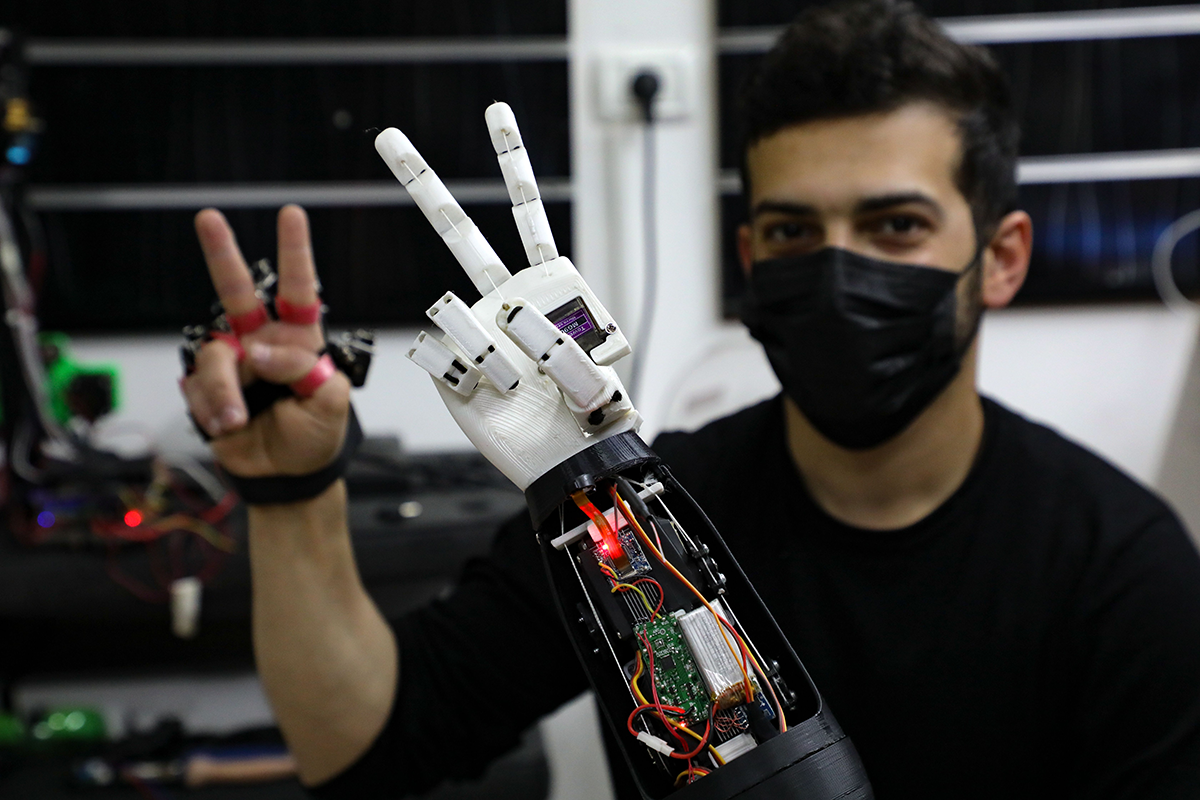This article is part of the publication Thinking MENA Futures, produced in conjunction with MEI's Strategic Foresight Initiative and the MEI Futures Forum. Read the other articles in the series here.
The world will remember 2020 as the year that witnessed an unprecedented acceleration in digital transformation instigated by the disruption of COVID-19. The pandemic affected millions of lives and livelihoods in the developed world and emerging economies, including the Middle East and North Africa (MENA) region. However, it also presented ample opportunities for economies to reimagine how the future will look while adapting to emerging innovative technologies and their economic implications.
MENA countries have an opportune moment to leverage the power and reach of digitalization and positively impact their economic development while expanding access to basic needs, including several sustainable development goals such as efficient government services, financial inclusion, and job creation. Digital transformation can make a significant difference in MENA. However, it should be supported by digital infrastructure, skilled human capital, and the proper legal, regulatory, investment, governance, educational, security, and other enabling environments.
Digital transformation is a journey, and although there has been varying progress across different MENA countries, there is still a lot that needs to be done so that economies and societies benefit from it. Digitalization goes way beyond the deployment and access to a state-of-the-art digital infrastructure. For MENA to maximize its prospects from digital transformation, each country needs to continuously invest in the following:
- Technology infrastructure — the heart and soul of the network economy — by providing affordable, universal access and localized content coupled with accelerating the adoption level and preparedness in society to integrate digital economy platforms such as artificial intelligence, cloud computing, big data analytics, and the Internet of Things;
- Human capital — the most valuable asset of the economy — should be digitally-ready with the upskilling and reskilling of capacities through lifelong learning and vocational training to help navigate the challenges of the 21st century such as digitalization and the impact on the future of work, efficiency and productivity of individuals, private and public enterprises, and the government; and
- Governance — the checks and balances mechanism — with its multifaceted benefits, including a legal and regulatory environment that can help build trust, create transparency, and enable inclusivity.
In the digital economy, economic diversification is fueled by investing in entrepreneurship, innovation, creativity, and the evolution of a tech startup culture that can promote the digitalization of various economic sectors. On this note, MENA is home to a fast-growing entrepreneurial ecosystem. It has increasingly been attracting local and international investors supporting primarily innovative and tech-enabled startups contributing to the acceleration of digital transformation. However, the impact of tech-enabled startups on creating job opportunities and reducing youth unemployment remains modest. Scaling up the existing efforts could be achieved by establishing university-based incubators and accelerators across MENA coupled with establishing tech hubs comprised of universities, enterprises, and research centers to promote science, technology, and innovation and collaboration among them.
Digital transformation can transform small and medium-sized enterprises (SMEs), which represent most enterprises in MENA, and help them transition into the digital economy. However, today, most SMEs do not take advantage of the digital environment. For example, e-commerce surged in recent years and accelerated due to the pandemic because of the changing market dynamics and consumer behavior; however, the volume of transactions compared to the prospects in MENA remains modest, requiring scaling up the digitalization in SMEs. Besides, the better the capacity for digitalization, the more improved social and economic resilience. In general, it is expected that MENA economies will be affected by digitalization, each depending on the readiness of society and adaptation to a more tech-driven and digitally-enabled environment.
However, despite the opportunities for economic growth and productivity that digitalization offers, the unprecedented rate of change and innovation is creating high levels of uncertainty. The magnitude varies from positive implications on different economic sectors to negative repercussions on employment, especially given the various changes related to the future of work. Therefore, the outcome of digitalization will be shaped by the policies and decisions made by MENA governments.

Financial inclusion can have a far-reaching impact on individuals and enterprises, offering opportunities for the unbanked segments of society to narrow the digital divide and help SMEs move from the informal sector into the mainstream economy, allowing them to improve their capacity to compete and grow. Digitalization helps enterprises expand their trade volume in physical goods and digital services, meet continuously changing consumer expectations, and compete in a growing electronic commerce environment. In agriculture, digitalization can help improve productivity and efficiency by connecting to new markets, improving logistics to rationalize resources, and providing access to global value chains. Artificial intelligence can help cultivate more land, while precision agriculture can enhance exportable products and conform to international regulations. Cellular agriculture can achieve a green and sustainable economy while contributing to food security and encouraging localized production. In manufacturing, digitalization can help embrace the value-chain mindset, including forming industrial clusters with enterprises whose businesses complement each other. With the increasing interdependency of value chains, MENA countries need to play a more effective role, especially with the growing importance of localization and on-shoring. Innovation-based manufacturing remains unexplored and introducing advanced digital production technologies and innovations such as blockchain, robotics, and 3D printing could help transform manufacturing, improve quality, accelerate innovation, increase efficiency, and create new industries.
Technological innovation has the potential to transform businesses regardless of industry or size. It can also contribute to economic growth, job creation, and human capital development, while reducing poverty and inequality by availing opportunities for a diversified and inclusive workforce, including women and youth. Therefore, as the pace of change accelerates, policymakers and enterprise owners must constantly innovate and adapt to remain relevant, competitive, and agile in a rapidly changing economic environment. To conclude, several MENA economies have shown some reasonable progress in the digitalization journey over the last few decades, but most are lagging. Such progress includes (a) some relatively advanced adoption by segments of the society on an individual basis; (b) a growing and promising although yet modest adoption by tech-enabled startups; (c) early-stage adoption of electronic government services; and (d) an insignificant ICT adoption level by private sector enterprises.
"Technological innovation has the potential to transform businesses regardless of industry or size."
MENA countries should enable a conducive environment and its associated policies for a future more likely to be driven by a digital ecosystem. This includes:
- Developing a multi-sector strategy addressing the digitalization of public services to improve efficiency, break the silos, reduce bureaucracy, combat corruption and red tape, improve governance, and ensure that the actions and legislation implemented help avoid exacerbating existing divides and become an equalizer not just of digital access but more importantly digital equity;
- Formulating an enabling legal environment with proper impact analysis tools that strikes the balance between fostering innovation to allow for business expansion and creating proper safeguards to protect the interests of individuals and enterprises.
- Constantly improving the digital infrastructure;
- Adopting a policy framework for research and development focused on the business opportunities enabled through digital transformation; and
- Expanding the entrepreneurial ecosystem to create new engines and drivers of growth, job creation, and improved living standards as well as investing in tech-enabled startups that support digitalization in economic sectors and industries.
While digital technologies provide new conveniences to many enterprises, there are growing concerns about the negative impacts of digital solutions and the implications of the rise of the gig economy given the size of the informal and self-employed segment, whose services are generally performed offline. These gig-workers will be able to source their business online, given the growing entrepreneurial space. In the future, with further dissemination of digital infrastructure and connectivity, coupled with an increasing level of ICT adoption, the potential impact of digitalization on MENA economies could be significant and a game-changer.
Sherif Kamel is Professor and Dean of the School of Business at the American University in Cairo.
Photo by Mahmoud Bakkar/picture alliance via Getty Images
The Middle East Institute (MEI) is an independent, non-partisan, non-for-profit, educational organization. It does not engage in advocacy and its scholars’ opinions are their own. MEI welcomes financial donations, but retains sole editorial control over its work and its publications reflect only the authors’ views. For a listing of MEI donors, please click here.













